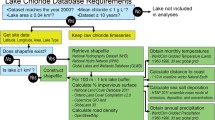Abstract
The temporal distribution of chloride concentration in the Oswego River was determined at 6 hr intervals for a 3 mo period during the summer of 1982. The dynamics of relative flow and chloride contributions from the three major sources forming the Oswego River, and the dynamics of flow releases from one of the sources, chloride-polluted Onondaga Lake, were determined from the above measurements, available chloride concentrations, and flow data for the system, through application of a simple mass balance on chloride. The chloride concentration and load in the Oswego River were found to be highly variable with time, and largely due to the dynamics of flow release from Onondaga Lake. The chloride distribution in the Oswego River, with its unique dynamics and chemically conservative nature, make it a valuable hydraulic tracer for the system.
Similar content being viewed by others
References
Babiarz, P. and Pilon, K.: 1979, ‘Water Quality Management on the Eastern Oswego River Basin’, Central New York Regional Planning and Development Board, 31 pp.
Bevington, P. R.: 1969, Data Reduction and Error Analysis for the Physical Sciences, McGraw-Hill, New York, New York.
Calocerinos and Spina Engineers: 1982, Unpublished data.
Eder, Connors, and Associates: 1978, ‘Waste Assimilative Capacity Evaluation of the Oneida-Seneca-Oswego River System’, prepared for General Foods-Nestles Enterprises, Fulton, New York.
Effler, S. W.: 1980, Unpublished data available upon request.
Effler, S. W., Field, S. D., Meyer, M. A., and Sze, P.: 1981, Jour. Env. Eng. Div., ASCE, 107, 191.
Effler, S. W. (ed.): 1982, ‘A Preliminary Water Quality Analysis of the Three Rivers System’. The Upstate Freshwater Institute, Inc.
Effler, S. W., McCarthy, J. M., Simpson, K. W., Unangst, F. J., Schatran, G. C., Schecher, W. D., Jaran, P., Hsu, H. A., and Khalil, M. T.: 1983a, Water, Air, and Soil Pollut. 21, 335.
Effler, S. W.: 1983, Jour. Great Lakes Res (in review).
Effler, S. W., Jaran, P., and Carter, C. F.: 1983b, Jour. Env. Eng. Div., ASCE, 109, 945.
Field, S. D.: 1980, ‘Nutrient- Saturated Algal Growth in Hypereutrophic Onondaga Lake, Syracuse, New York’, Ph.D. Thesis, Syracuse University, Syracuse, New York.
Krenkel, P. A. and Novotny, V.: 1980, Water Quality Management, Academic Press, New York, New York.
Lawler, Matusky, and Shelly Engineers: 1978, ‘Central New York Water Quality Management Program; Projected Wasteloads, Flows and Allocations (Vol. 2)’, prepared for the Central New York Regional Planning and Development Board.
New York State Department of Environmental Conservation: 1971, 1972, 1973, 1974, 1975, 1976, 1977, 1978, 1979, 1980, 1981, unpublished data supplied upon request.
New York State Department of Environmental Conservation: 1977, ‘Draft — Phase I - 303(3) Water Quality Management Plan for Eastern Oswego River Basin’, Division of Land Resources and Forest Management and Division of Pure Waters, Albany, New York.
Northcote, T. C. and Larkin, P. A.: 1956, J. Fish. Res. Bd. Can. 15, 1515.
O'Brien and Gere Engineers: 1977, ‘Water Quality Survey of the Seneca-Oneida-Oswego River’, prepared for the Central New York Regional Planning and Development Board.
Onondaga County: 1971, ‘Onondaga Lake Study’, Water Quality Office, United State Environmental Protection Agengy, Water Pollution Control Research Series, Report 11060.
Onondaga County: 1971, 1972, 1973, 1974, 1975, 1976, 1977, 1978, 1979, 1980, 1981, 1982, ‘Onondaga Lake Monitoring Program’, Annual publication, Onondaga County, New York.
Rawson, D. S.: 1951, Ecology 32, 669.
Remane, A. and Schleeper, C.: 1971, The Biology of Brackish Water, Wiley and Sons, New York, New York.
Richardson, W. L.: 1976, ‘An Evaluation of the Transport Characteristics of Saginaw Bay Using a Mathematical Model for Chloride’, in R. P. Canale (ed.), Modeling Biochemical Processes in Aquatic Ecosystem, Ann Arbor Science, Ann Arbor Michigan, pp. 113–140.
Seenayga, G.: 1973, Hydrobiol. 41, 529.
Seeger, E. S.: 1980, ‘The Fate of Heavy Metals in Onondaga Lake’, Masters Thesis, Clarkson College, Potsdam, New York.
Sonzogni, W. C., Richardson, W., Rodgers, P., and Monteith, T. J.: 1983, Jour. Wat. Poll. Cont. Fed. 55, 513.
Stoermer, E. F., Bowman, M. M., Kingston, J. C., and Schaedel, A. L.: 1975, ‘Phytoplankton Composition and Abundance in Lake Ontario During IFYGL’, University of Michigan Great Lakes Research Division, Special Report No. 53, 373 pp.
Stoermer, E. F.: 1978, Trans. Amer. Micros. Soc. 97, 2.
Thomann, R. V.: 1972, Systems Analysis and Water Quality Management, Wiley and Sons, New York, New York.
Thomann, R. V.: 1982, Jour, Envir. Eng. Div., ASCE, 108, 923.
United States Geological Survey: 1983, ‘Water Resources Data for New York, Water Year 1982, Western New York’, Annual Report, Albany, New York.
Author information
Authors and Affiliations
Additional information
Contribution No. 24 of the Upstate Freshwater Institute, Inc.
Rights and permissions
About this article
Cite this article
Effler, S.W., Perkins, M.G. & Field, S.D. Onondaga Lake and the dynamics of chloride in the Oswego River. Water Air Soil Pollut 23, 69–80 (1984). https://doi.org/10.1007/BF00185132
Received:
Revised:
Issue Date:
DOI: https://doi.org/10.1007/BF00185132




